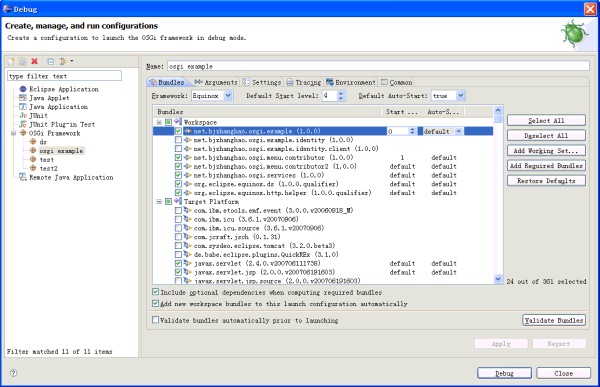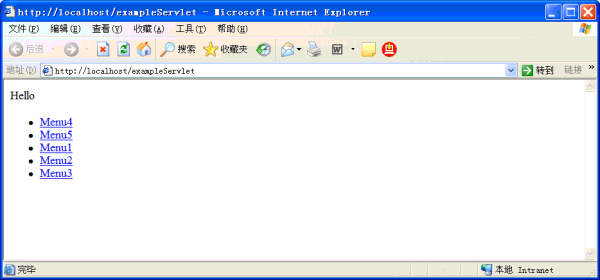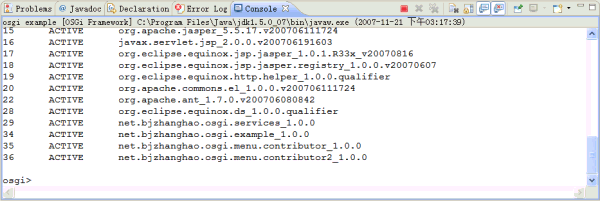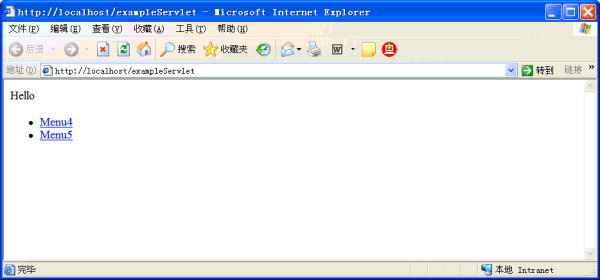Eclipse的插件体系结构让我们可以灵活定义插件,组装成可插拔的软件系统,OSGi的Declarative Services(DS)有着和Eclipse扩展点类似的思想(见很详细的一篇对比文章),很自然的想到,如果把DS应用在Web应用程序上,我们将能够通过定义自己的“扩展点”,打造SOA的Web应用程序。题目中“可配置”是指,根据用户需求,提供给客户不同的包即可形成针对该客户定制的产品/解决方案。
现在来试试怎样用DS实现动态配置一个Web应用程序界面里菜单,使用的OSGi实现还是Equinox。Eclipse里菜单项是通过实现actionSets、editorActions等等扩展点添加的,在OSGi里没有这些“扩展点”,没关系,我们可以自己定义。
一、用一个Bundle定义Java接口文件,和Eclipse扩展点的功能类似,这些接口可以作为服务的接入点。例子里这个Bundle的ID是net.bjzhanghao.osgi.services,接口类是IMenuContributor,内容很简单如下所示:
public interface IMenuContributor {
public List<MenuItem> getItems();
}上面用到的MenuItem是自己定义的一个简单的数据结构,包含name和url两个String类型的成员变量和相应的getter/setter方法,这里就不展示了。
二、用0..n个Bundle实现上面定义的接口(暂时称之为Contributor),并声明为服务。例子里有两个这样的Bundle,ID分别是net.bjzhanghao.osgi.menu.contributor和net.bjzhanghao.osgi.menu.contributor2,实现类都是MyMenuContributor,前者提供了Menu1..3,后者提供了Menu4..5;以下是服务的声明,即项目里OSGI-INF/component.xml文件的内容:
<?xml version="1.0" encoding="UTF-8"?>
<component name="services">
<implementation
class="net.bjzhanghao.osgi.menu.contributor.MyMenuContributor"/>
<service>
<provide interface="net.bjzhanghao.osgi.services.IMenuContributor"/>
</service>
</component>MyMenuContributor实现IMenuContributor,你可以任意实现它,例子里是让它提供三个菜单项:
public class MyMenuContributor implements IMenuContributor {
public List<MenuItem> getItems() {
List<MenuItem> list = new ArrayList<MenuItem>();
list.add(new MenuItem("Menu1", null));
list.add(new MenuItem("Menu2", null));
list.add(new MenuItem("Menu3", null));
return list;
}
}三、现在SOA的一半工作也就是注册服务的部分完成了,剩下要做的是另一半,消费这些服务。首先在web应用程序Bundle里,创建一个Helper类收集这些服务,这个Helper类的功能相当于一个Registry。例子里这个Bundle的ID是net.bjzhanghao.osgi.example,Helper类是MenuHelper;以下是对MenuHelper的配置,即项目里OSGI-INF/component.xml文件的内容,这样OSGi在启动Bundle时会把实现IMenuContributor的服务通过addMenuContributor方法注册到MenuHelper里,注意cardinality的值要为"0..n",policy的值要为"dynamic":
<?xml version="1.0" encoding="UTF-8"?>
<component name="menuHelper">
<implementation
class="net.bjzhanghao.osgi.example.MenuHelper"/>
<reference name="menuHelper"
interface="net.bjzhanghao.osgi.services.IMenuContributor"
cardinality="0..n"
policy="dynamic"
bind="addMenuContributor"
unbind="removeMenuContributor"
/>
</component>四、在JSP/Servlet里,利用上面的Helper类构造界面(或业务逻辑)。因为我们定义的接口是关于菜单的,所以例子应用的菜单会根据Bundle配置(启动/停止)变化。例子里是在ExampleServlet里实现的,代码很简单如下所示:
protected void doGet(HttpServletRequest req, HttpServletResponse resp) throws ServletException, IOException {
resp.setContentType("text/html");
resp.getWriter().write("Hello<br/>");
resp.getWriter().write("<ul>");
for (IMenuContributor menuContributor : MenuHelper.getInstance().getMenuContributors()) {
for (MenuItem mItem : menuContributor.getItems()) {
resp.getWriter().write("<li><a href=\"" + mItem.getUrl() + "\">" + mItem.getName() + "</a></li>");
}
}
resp.getWriter().write("</ul>");
}五、执行方式:
1、在Eclipse里导入代码包里所有项目,启动上述所有项目及其依赖的项目(Add Required Bundles),见下图:

2、在浏览器里输入地址http://localhost/exampleServlet,应该可以看到五个菜单项,见下图(这个简单的例子里没有考虑顺序问题,所以Menu4..5可能出现在前面,使用类似Eclipse里为Menu预留位置的方式可以解决):

3、回到Eclipse,在Console里输入ss查看当前的Bundle,应该可以看到类似下图的内容:

4、在Console里输入stop 35(35是Contributor的Bundle序号),Console会提示“Calling removeMenuContributor”,然后到浏览器里刷新页面,应该看到菜单项只剩下Menu4..5。

搬家前链接:https://www.cnblogs.com/bjzhanghao/archive/2007/11/21/967320.html


